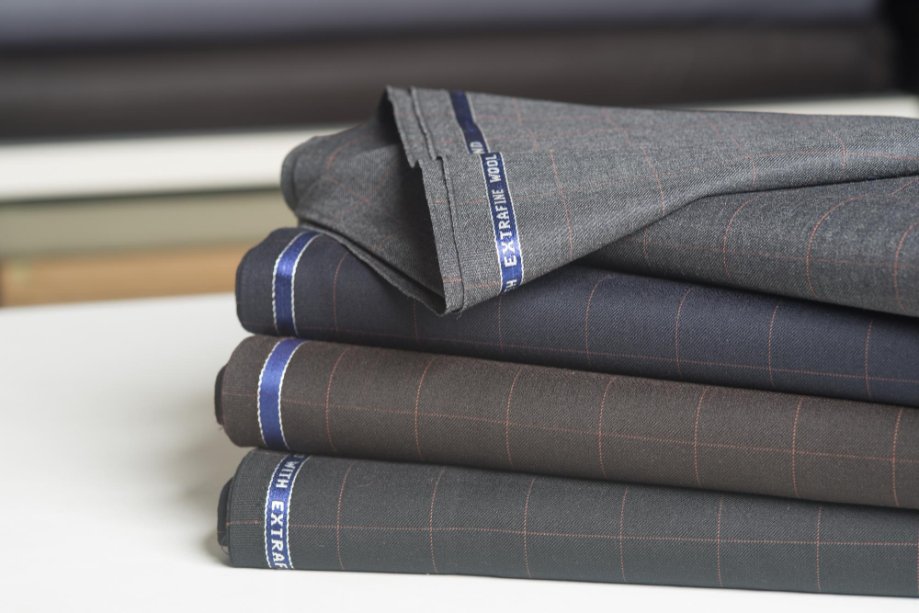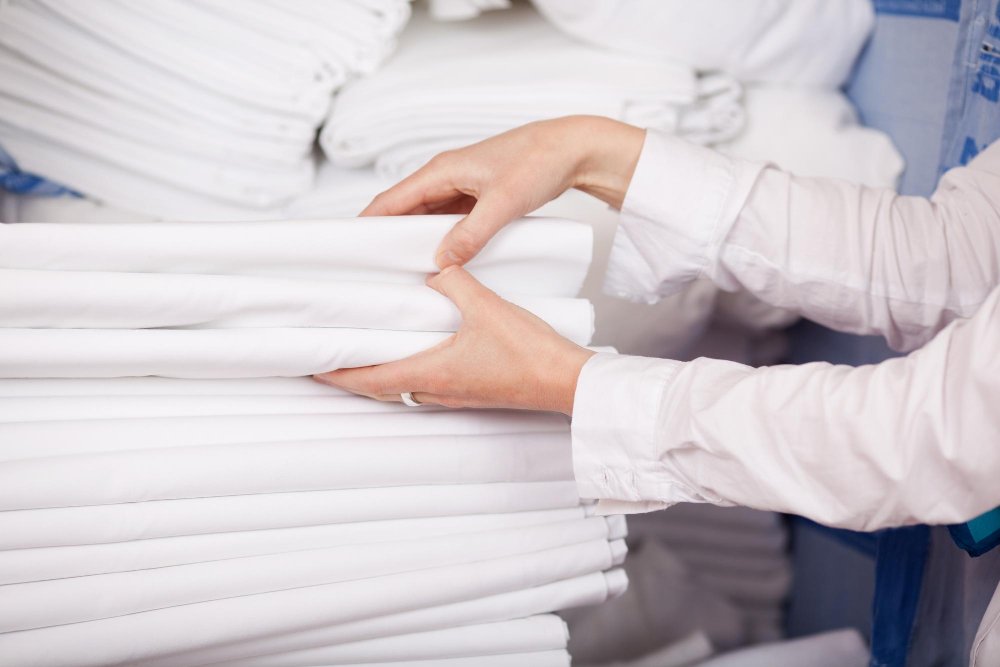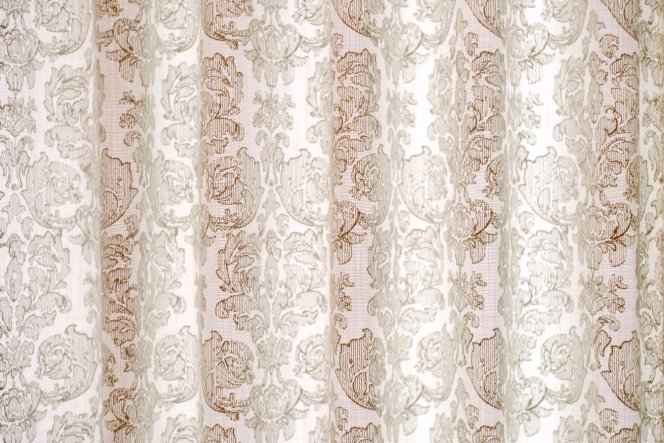Everything you need to know about linen suiting fabric, from fiber structure to fit recommendations
Table of Contents
- What is Linen Suiting Fabric?
- GSM Weight Guide for Linen Suiting
- Fabric Properties and Quality Indicators
- Regional Production Comparison
- Performance Benefits
- Environmental Footprint
- Selecting Linen Suits by Body Type
- When NOT to Wear Linen Suits
- Fabric Comparison Matrix
- Construction and Lining Options
- Investment and Price Guide
- Common Challenges and Solutions
- Care, Maintenance, and Lifecycle
- Frequently Asked Questions
What is Linen Suiting Fabric?
Linen suiting fabric originates from flax plant fibers that have been cultivated for over 36,000 years. The material consists of cellulose fibers extracted from flax stems through a process called retting, then spun into yarn and woven into cloth. Unlike casual linen fabric, linen suiting features specific weave densities and finishes designed to maintain structure in tailored garments.
What Does Suiting Fabric Mean?
Suiting fabric refers to textiles engineered for structured garments like jackets and trousers. These fabrics balance several properties: enough weight to drape properly, sufficient stiffness to hold shape, appropriate texture for professional appearance, and durability to withstand regular wear. Linen suiting typically weighs between 180-280 GSM (grams per square meter), compared to 120-160 GSM for shirting linen.
Is Linen Good for a Suit?
Linen performs well for suits in specific conditions. The fabric’s hollow fiber structure creates natural air channels that conduct heat away from the body 40% faster than wool blends, according to 2024 textile laboratory tests. This makes linen suits particularly effective when ambient temperatures exceed 75°F (24°C). However, the material’s tendency to wrinkle and limited insulation properties make it less suitable for cold weather or situations requiring crisp appearance throughout extended wear.
Bottom Line: Linen works best for suits worn in warm climates, outdoor events, and situations where a relaxed professional appearance is acceptable. The fabric trades wrinkle resistance for superior breathability.
GSM Weight Guide for Linen Suiting
Fabric weight determines how linen suiting performs in different applications. GSM (grams per square meter) measures the density of fibers per unit area. Use this guide to select appropriate weight for your needs:
| Weight Category | GSM Range | Best Applications | Structure Level |
|---|---|---|---|
| Lightweight | 150-180 GSM | Unlined summer shirts, casual blazers | Minimal structure |
| Medium-weight | 180-220 GSM | Summer suits, half-lined jackets, dress trousers | Moderate structure |
| Heavy-weight | 220-280 GSM | Three-season suits, professional blazers, structured pants | Good structure |
| Extra-heavy | 280+ GSM | Winter-weight linen, outerwear, upholstery | Maximum structure |
Pro Tip: For your first linen suit, select fabric in the 200-220 GSM range. This weight maintains professional structure during business meetings while providing summer comfort. Test the fabric between your fingers; it should feel substantial without excessive stiffness.
Calculate exact fabric requirements for your project using our Linen Fabric Weight Calculator.
Fabric Properties and Quality Indicators
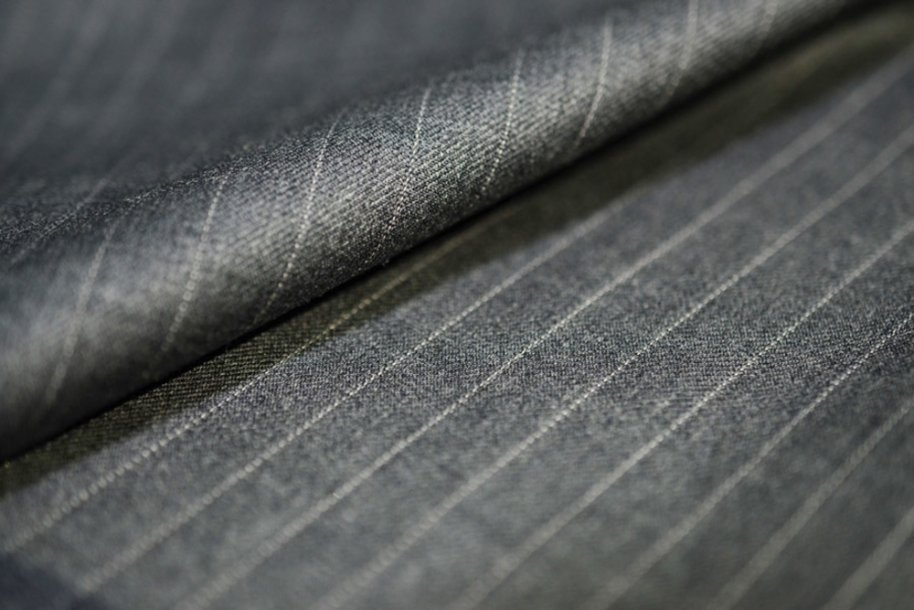
Natural Fiber Structure
Flax fibers measure 2-3 times longer than cotton fibers, creating fabric with distinct characteristics. The fibers contain irregular thicknesses called slubs, which produce linen’s signature textured appearance. These natural variations prevent the smooth, uniform surface found in worsted wool or satin fabric.
Quality linen suiting exhibits several measurable properties:
- Tensile strength: Pure linen retains 94% of its strength after 50 washes, compared to 76% for cotton
- Moisture absorption: Linen absorbs up to 20% of its weight in water before feeling damp
- Heat conductivity: The material releases body heat faster than most natural fibers
- Durability: Well-made linen suits can last 10-20 years with proper care
Weave Density and Texture
Linen suiting typically uses plain weave construction, where warp and weft threads pass over and under each other in simple alternation. This creates a balanced, stable fabric. Higher-end options may feature more complex weaves like damask for decorative texture.
Evaluate weave quality by holding fabric to light. Premium linen shows consistent spacing between threads with minimal irregularities. The weave should feel tight enough to resist snagging but open enough to allow airflow.
What is the Best Quality Fabric for Suits?
No single “best” fabric exists for all suit applications. The optimal choice depends on climate, occasion, and personal preferences:
| Fabric Type | Temp Range | Formality Level | Key Advantage |
|---|---|---|---|
| Worsted Wool | 50-70°F | High | Wrinkle resistance, year-round versatility |
| Pure Linen | 75-95°F | Medium | Maximum breathability, natural cooling |
| Tropical Wool | 70-85°F | High | Professional appearance with good ventilation |
| Linen-Wool Blend | 65-80°F | Medium-High | Balanced structure and breathability |
For hot weather specifically, linen outperforms other natural fibers in breathability. However, tropical wool offers better wrinkle resistance while maintaining professional appearance.
Regional Production Comparison
Flax cultivation concentrates in Western Europe, where climate conditions favor the plant’s growth. Europe produces the highest quality flax fiber globally, with the European flax industry accounting for the vast majority of premium linen production. Each region produces linen with distinct characteristics based on processing methods and fiber selection:
| Region | Characteristics | Typical GSM | Price Point |
|---|---|---|---|
| Belgian Flax | Industry standard; consistent quality; sustainable practices | 180-240 | $$-$$$ |
| Irish Linen | Fine, soft hand; traditionally used for luxury shirting | 150-180 | $$$ |
| French Linen | Slightly coarser; excellent for structured suiting | 200-280 | $$-$$$ |
| Italian Linen | Finest processing; softest finish; premium quality | 160-220 | $$$-$$$$ |
Certification Matters: Look for “Masters of Linen™” certification, which guarantees European origin and sustainable practices. According to the Alliance for European Flax-Linen & Hemp, certified flax requires no irrigation under normal conditions and uses 13 times fewer pesticides than potatoes.
Performance Benefits
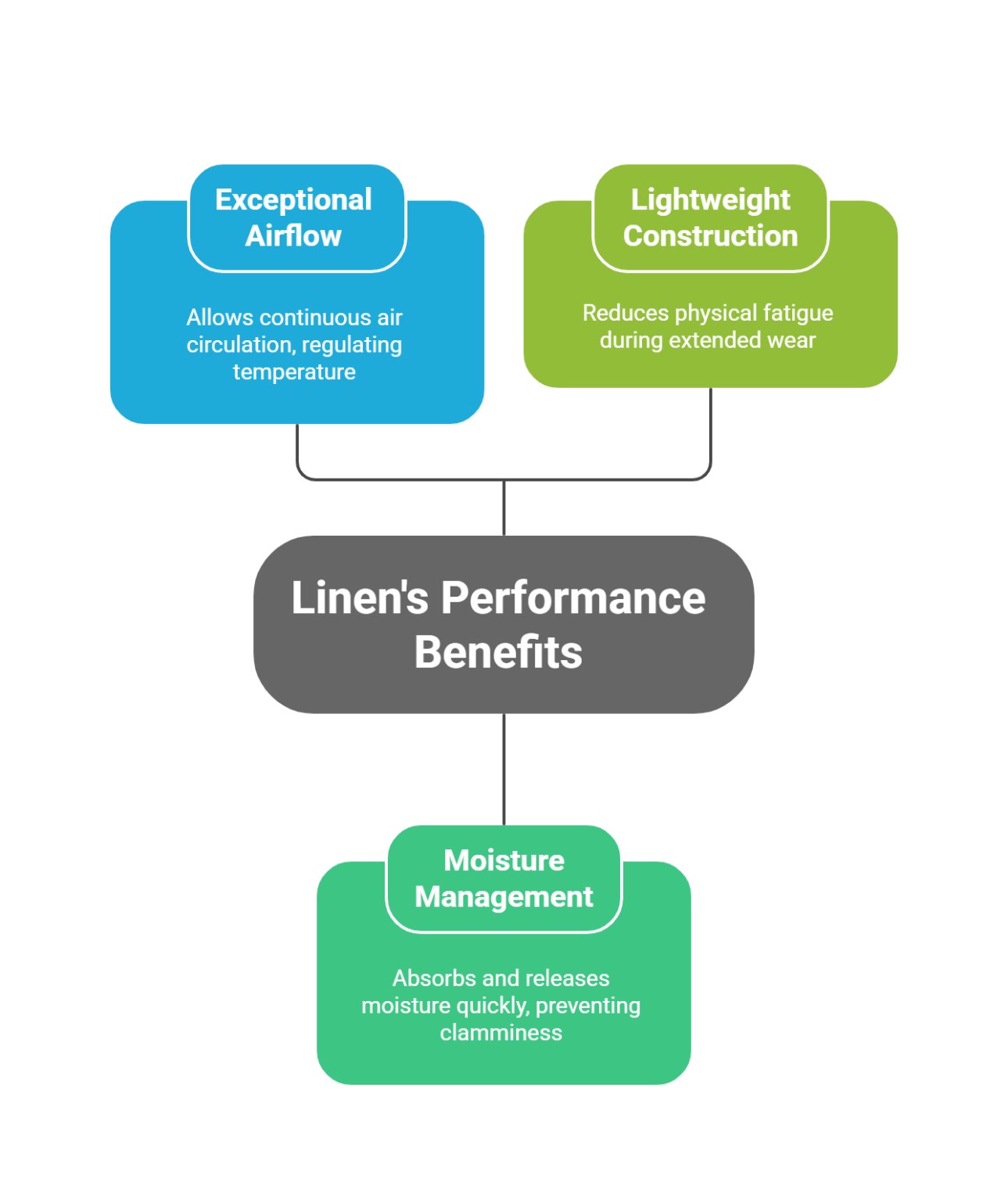
Are Linen Suits Good for Hot Weather?
Yes, linen suits deliver superior performance in hot weather compared to most alternatives. The fabric’s benefits in high temperatures include:
Exceptional Airflow: Linen’s open weave structure allows continuous air circulation against skin. Laboratory tests show the material facilitates 40% faster heat escape than comparable wool blends. This creates a microclimate between fabric and body that actively regulates temperature.
Moisture Management: Flax fibers absorb moisture quickly, then release it through evaporation. A linen suit dries in approximately 12 minutes after exposure to sweat, compared to 35 minutes for traditional wool. This rapid moisture-wicking prevents the clammy sensation common with other fabrics in humid conditions.
Lightweight Construction: Suiting linen typically weighs 5-7 ounces per square yard, versus 9-11 ounces for wool. This reduced weight decreases physical fatigue during extended wear. Surveys of professionals report 30% less tiredness when wearing linen suits during all-day outdoor events.
| Property | Linen Suits | Wool Suits | Cotton Suits |
|---|---|---|---|
| Breathability | Excellent (highest natural fiber) | Moderate to Good | Good |
| Drying Time | 12 minutes | 35 minutes | 20 minutes |
| Weight | 5-7 oz/yd² | 9-11 oz/yd² | 6-8 oz/yd² |
| Heat Conductivity | High (rapid heat escape) | Low (insulating) | Moderate |
Hypoallergenic Properties: Linen’s smooth fiber surface reduces friction against skin, making the fabric suitable for people with sensitive skin conditions. Dermatologists recommend linen for its low allergen content and natural antibacterial properties.
Explore more summer fabric options in our summer fabrics guide.
Environmental Footprint
Linen production demonstrates measurably lower environmental impact compared to many textile alternatives. Understanding these differences helps make informed purchasing decisions.
Water Consumption
Flax cultivation requires significantly less water than cotton production. According to life cycle assessment data, a linen shirt uses 6.4 liters of water across its complete lifecycle, compared to thousands of liters for an equivalent cotton shirt. European-grown flax typically requires no irrigation under normal weather conditions, relying instead on natural rainfall.
The water footprint breaks down as follows:
- Blue water (irrigation): 481 liters per kilogram
- Green water (rainfall): 2,866 liters per kilogram
- Gray water (pollution): 436 liters per kilogram
Compare this to conventional cotton at 4,242 liters per kilogram blue water and 4,264 liters per kilogram green water. Choosing linen reduces blue water consumption by 88%.
Chemical Use and Pesticides
Flax plants demonstrate natural resistance to pests, requiring minimal chemical intervention. Data from the United Nations Food and Agriculture Organization shows flax uses 13 times fewer pesticides than potato crops, despite occupying similar agricultural space.
However, non-organic linen may still involve nitrate fertilizers and chemical retting processes. For lowest environmental impact, look for these certifications:
- GOTS (Global Organic Textile Standard): Guarantees organic farming without synthetic pesticides or fertilizers
- European Flax™: Certifies traceable European origin with integrated crop management
- Oeko-Tex Standard 100: Tests final products for harmful substances
Carbon Footprint
Flax plants act as carbon sinks during growth, absorbing CO₂ from the atmosphere. The cultivation phase produces negative emissions before processing begins. Manufacturing linen fabric requires 82% less energy than conventional cotton production.
Environmental Reality Check: While linen production starts with low impact, the consumer use phase accounts for approximately 80% of total energy consumption due to washing and ironing. To maximize sustainability, wash linen suits only when necessary and accept natural wrinkles rather than frequent pressing. Good On You ranks organic linen among the most sustainable fabrics available.
Learn more about sustainable fabric choices in our guide to natural vs synthetic fabrics.
Selecting Linen Suits by Body Type
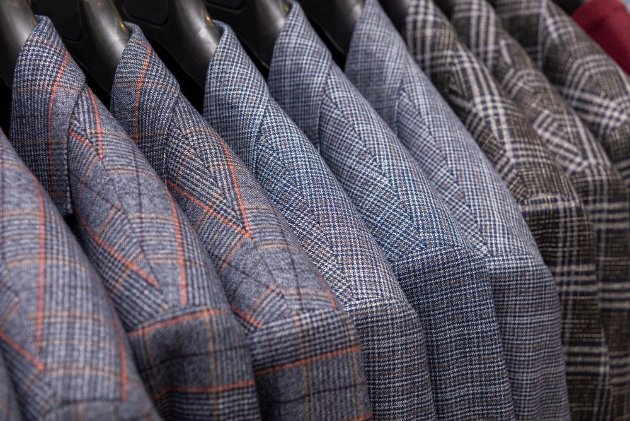
Linen’s natural drape and texture affect different body types distinctly. Match fabric weight and cut to your build for optimal appearance.
| Body Type | Recommended GSM | Cut Style | Why It Works |
|---|---|---|---|
| Tall/Slim | 180-200 | Double-breasted; patterns; lighter colors | Moderate weight adds visual dimension; patterns create width; linen’s texture prevents appearing too thin |
| Athletic/Broad | 200-220 | Single-breasted; tapered waist; notch lapels | Structured weight maintains shape through chest; taper accentuates V-shape; notch lapels balance shoulders |
| Heavy/Stocky | 220+ | Single-breasted; dark colors; peak lapels | Heavier linen drapes vertically for elongation; dark colors create slimming effect; peak lapels draw eye upward |
| Short/Petite | 180-200 | Slim-fit; monochrome; shorter jacket length | Lighter weight won’t overwhelm smaller frame; single color creates vertical line; linen’s natural texture adds interest |
Fit Guidelines by Body Type
For Tall/Slim Builds: Choose jackets with structured shoulders and slight padding to add width. Patterns like checks or herringbone create visual bulk without actual weight. Avoid pinstripes, which further emphasize height. Consider three-piece suits; the waistcoat adds dimension to the torso. Pants should have medium to full break and optional cuffs to balance long legs.
For Athletic/Broad Builds: Select suits sold as separates, as standard sizing often can’t accommodate the difference between shoulder width and waist measurement. Look for jackets that taper from chest to waist to show your natural V-shape. Avoid excess fabric in the midsection. Slim-fitting pants work well, but ensure adequate room in thighs and seat for comfort.
For Heavy/Stocky Builds: Single-breasted jackets with two buttons create a longer vertical line than three-button or double-breasted styles. Choose deeper button stance to form a stronger V-shape. Vertical patterns like pinstripes or subtle herringbone elongate the frame. Avoid horizontal elements. Straight-leg pants with proper rise (sitting across bottom of belly, not under it) provide best proportion.
For Short/Petite Builds: Shorter jacket length (just covering the seat) prevents overwhelming smaller frames. Keep sleeves and pants properly hemmed; excess fabric adds visual bulk. Single-button jackets with high button placement lengthen the torso. Narrow lapels and minimal break on trousers maintain proportion. Avoid large patterns that dominate your frame.
Use our Body Type Calculator to determine your specific measurements and receive personalized recommendations.
When NOT to Wear Linen Suits
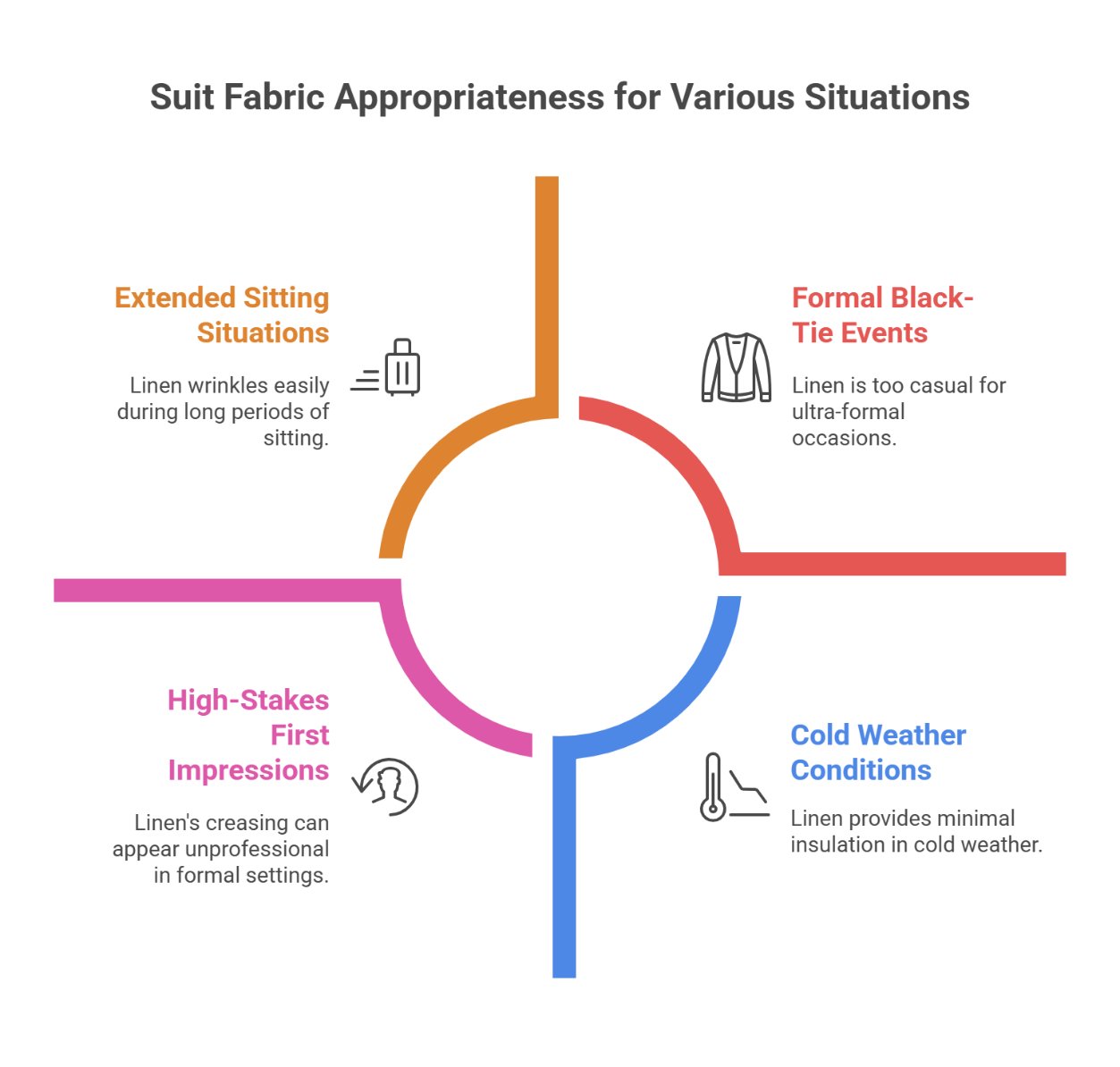
Understanding linen’s limitations prevents disappointing experiences. Avoid linen suits in these situations:
Formal Black-Tie Events
Linen’s natural texture and tendency to wrinkle make it inappropriate for ultra-formal occasions requiring black tie or white tie dress codes. Traditional wool tuxedos or wool-silk blends remain the standard for these events. Linen reads as too casual regardless of color or quality.
Is a Linen Suit Too Informal? Not for most situations. Linen suits work well for business casual offices, outdoor weddings, summer conferences, and destination events. However, conservative corporate environments and formal evening affairs still expect wool or wool-blend suiting.
Cold Weather Conditions
Linen provides minimal insulation below 60°F (15°C). The fabric’s open weave, designed for hot-weather ventilation, allows cold air to pass through freely. In temperatures below 55°F, you’ll feel uncomfortably cold even with layering. Choose wool, tweed, or flannel for autumn and winter wear.
High-Stakes First Impressions
Job interviews at conservative companies, initial client meetings in traditional industries (law, finance, consulting), and situations where appearance directly affects outcomes may benefit from wrinkle-resistant fabrics. While linen projects confidence and style awareness, severe creasing can read as unprofessional in these contexts. Tropical wool offers similar breathability with better wrinkle resistance.
Extended Sitting Situations
Long flights, multi-hour car trips, and day-long conferences cause pronounced creasing in linen suits. The fabric wrinkles immediately when you bend joints or compress fabric through sitting. If you need to look fresh after extended seated periods, choose wool blends or linen-polyester combinations that resist creasing.
All-Day Crisp Appearance Requirements
Events requiring sharp appearance from morning through evening work better with alternative fabrics. Linen begins showing wear after 2-3 hours of active movement. Wedding party members, presenters at all-day conferences, and professionals with back-to-back meetings should consider tropical wool or performance synthetic blends.
Better Alternatives by Situation
| Situation | Why Avoid Linen | Better Choice |
|---|---|---|
| Black-tie events | Too casual; excessive wrinkles | Wool tuxedo or wool-silk blend |
| Outdoor winter activities | No insulation; wind passes through | Wool tweed or flannel |
| Conservative job interviews | Wrinkles may appear sloppy | Worsted wool or tropical wool |
| Long flights/car trips | Extreme creasing from sitting | Wool-polyester blend (60/40) |
| All-day presentations | Loses crispness after 2-3 hours | Performance fabrics or tropical wool |
Fabric Comparison Matrix
Compare linen against alternative suiting fabrics to understand trade-offs:
| Property | Pure Linen | Linen-Cotton | Linen-Wool | Tropical Wool | Cotton |
|---|---|---|---|---|---|
| Breathability | Excellent | Very Good | Good | Very Good | Good |
| Wrinkle Resistance | Poor | Fair | Good | Excellent | Fair |
| Structure | Fair | Good | Excellent | Excellent | Fair |
| Moisture Wicking | Excellent | Very Good | Good | Good | Poor |
| Durability | Excellent (improves with age) | Very Good | Excellent | Very Good | Good |
| Price Range | $$-$$$ | $$-$$$ | $$$-$$$$ | $$$-$$$$ | $-$$ |
| Best Climate | Hot, dry (75-95°F) | Warm (70-85°F) | Transitional (65-80°F) | Business travel (65-85°F) | Casual summer (70-85°F) |
Use our Interactive Fabric Comparison Tool to explore detailed differences between materials.
Construction and Lining Options
Jacket construction significantly affects how linen suits perform in warm weather. Lining reduces breathability but adds structure and smooth interior finish.
| Construction Type | Breathability | Structure | Best For |
|---|---|---|---|
| Fully Unlined | Maximum (15-20% cooler) | Minimal | Extreme heat (85°F+); casual occasions; beach events |
| Quarter-Lined | Excellent | Light | Hot weather with professional appearance needs |
| Half-Lined | Very Good | Moderate | Summer business wear; outdoor weddings |
| Fully Lined | Reduced (~30% less) | Maximum | Transitional weather; air-conditioned environments |
Understanding Each Construction Type
Fully Unlined: The jacket interior exposes all seams and construction. This provides maximum airflow but shows imperfect finishing. Suitable only for casual summer wear where comfort trumps polish. The lack of lining means you’ll feel fabric texture directly against shirt fabric.
Quarter-Lined: Lining covers only the shoulders and upper back, stopping at shoulder blade level. This construction allows air circulation across most of the back while providing smooth shoulder fit. Good balance between breathability and professional appearance.
Half-Lined (Recommended): Sleeves receive full lining for easy on/off movement, while the back remains unlined for ventilation. This represents the optimal choice for linen suiting in most situations. You get convenience with minimal breathability sacrifice.
Fully Lined: Complete interior lining from shoulders through hem. Provides smoothest finish and best shape retention but defeats linen’s cooling properties. Choose this only for air-conditioned indoor wear or transitional seasons.
Pro Tip: When ordering custom or made-to-measure linen suits, request half-lining with natural fiber lining material (cotton or silk) rather than synthetic. Synthetic linings trap heat and negate linen’s breathability advantages.
Investment and Price Guide
Is It Worth Buying a Linen Suit?
A linen suit represents worthwhile investment if you regularly experience temperatures above 75°F during suit-wearing occasions. The purchase makes sense for:
- Professionals working in warm climates or traveling to hot locations
- Summer wedding guests and wedding parties in outdoor venues
- Anyone attending multiple warm-weather formal events annually
- Building versatile seasonal wardrobe with specialized pieces
Skip the investment if you rarely need suits in hot weather or work exclusively in climate-controlled environments. A tropical wool suit offers more versatility for varied conditions.
Price Ranges and Value Assessment
| Price Tier | Cost Range | What You Get | Expected Lifespan |
|---|---|---|---|
| Entry-Level | $200-400 | Asian production; linen blends; 160-180 GSM; basic construction | 3-5 years |
| Mid-Range | $400-800 | European fabric; good construction; 180-220 GSM; half-lining option | 8-12 years |
| Premium | $800-1,500 | Irish/Belgian linen; bespoke options; 200-240 GSM; superior finishing | 15-20 years |
| Luxury | $1,500+ | Artisanal production; Italian processing; exclusive mills; hand-finishing | 20+ years |
Value Proposition Analysis
A well-made linen suit in the $600-900 range offers optimal value. This price point provides European fabric quality with construction that survives 10+ years of seasonal wear. Calculate true cost:
Example: $750 mid-range suit
- Purchase price: $750
- Expected lifespan: 10 years
- Dry cleaning: 6 times per year × $12 = $72 annually
- Total 10-year cost: $750 + ($72 × 10) = $1,470
- Wears per season: ~15 times
- Total wears: 150 over 10 years
- Cost per wear: $9.80
Compare this to entry-level suits requiring replacement every 3-4 years. Three $300 suits over 10 years cost $900 plus cleaning, with lower quality throughout.
Investment Recommendation: Spend $600-900 on your first linen suit. This range delivers European fabric, proper construction, and durability that justifies the cost. Look for Masters of Linen™ certification and request half-lining for optimal performance.
Common Challenges and Solutions
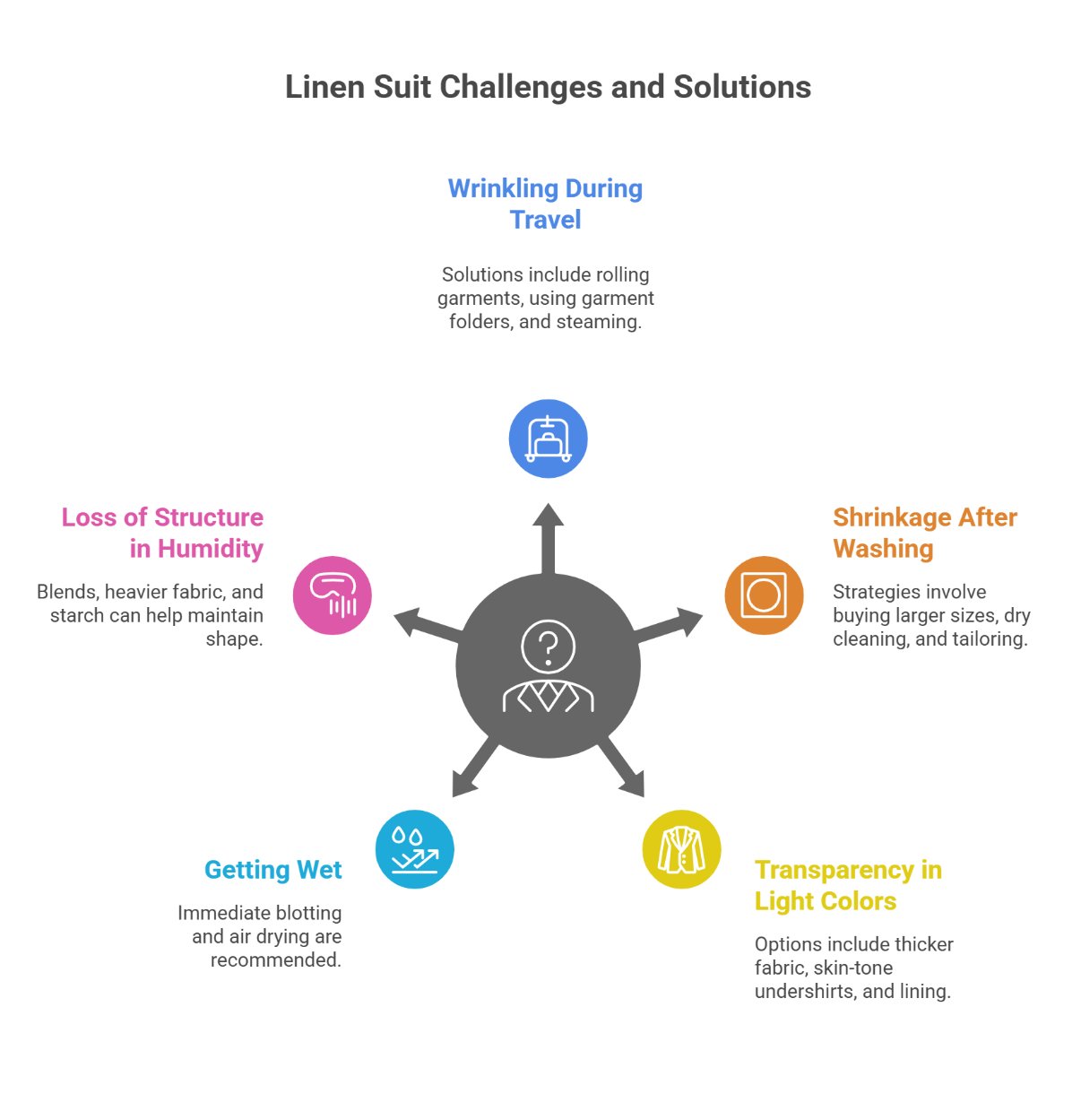
Address frequent linen suit problems with practical solutions:
Challenge: Excessive Wrinkling During Travel
Problem: Linen suits emerge from luggage severely creased, requiring immediate attention before wear.
Solutions:
- Roll garments instead of folding to distribute stress across fabric
- Use garment folders with built-in tissue paper layers
- Hang suit immediately upon arrival and run hot shower to create steam in bathroom
- Pack portable steamer for touch-ups (more effective than iron for linen)
- Accept natural wrinkles as part of linen’s character in casual settings
Challenge: Shrinkage After Washing
Problem: Linen suits shrink 1-3% during first wash, affecting fit.
Solutions:
- Purchase suits slightly large (½ size up) to account for shrinkage
- Dry clean rather than home wash if precise fit is critical
- If washing at home, use cold water and air dry flat
- Have tailor adjust after first cleaning once shrinkage stabilizes
Challenge: Transparency in Light Colors
Problem: White or pale linen suits show undergarments through fabric.
Solutions:
- Choose 200+ GSM fabric for better opacity
- Wear skin-tone undershirts (not white) to minimize visible lines
- Select off-white or cream instead of pure white
- Opt for half-lined construction; lining blocks transparency
Challenge: Can a Linen Suit Get Wet?
Problem: Unexpected rain or spills on linen suits.
Reality: Linen absorbs water readily but also dries quickly. Light rain won’t damage the fabric permanently, though it will cause temporary wrinkling and color darkening.
Solutions:
- Blot (don’t rub) water immediately with absorbent cloth
- Hang to air dry naturally; avoid direct heat
- Once dry, steam or press to remove water spots
- For heavy soaking, take to dry cleaner promptly
- Apply water-repellent treatment (available from dry cleaners) for extra protection
Learn more about fabric treatments in our water-resistant fabric guide.
Challenge: Loss of Structure in High Humidity
Problem: Linen suits appear limp and lose professional appearance in very humid conditions.
Solutions:
- Choose linen-wool blends (60% linen, 40% wool) for humid climates
- Select heavier fabric (220+ GSM) for better structure retention
- Opt for half-lined or fully-lined construction
- Apply light starch during pressing for temporary stiffness
- Consider tropical wool as alternative in extremely humid locations
Care, Maintenance, and Lifecycle
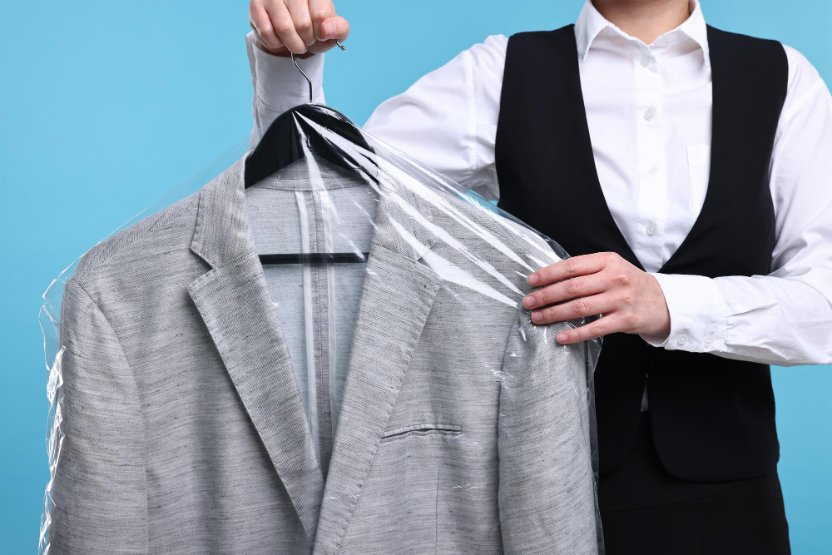
Professional vs. Home Care
Linen suits benefit from professional dry cleaning every 4-6 wears. This preserves color, maintains fabric integrity, and ensures proper pressing. The investment pays off through extended garment life.
Dry Cleaning Schedule:
- After every 4-6 wears (seasonal wear)
- Before storing for off-season
- Immediately after stains or heavy perspiration
- Minimum: 2-3 times per summer season
Home Care Instructions
For spot cleaning between professional services:
- Immediate spot treatment: Blot spills with cold water and clean white cloth. Never rub; this damages fibers.
- Air out after each wear: Hang suit in well-ventilated area for 24 hours before returning to closet. This allows moisture to evaporate.
- Use proper hangers: Wood or padded hangers that match shoulder width. Wire hangers create permanent dimples.
- Brush regularly: Soft clothes brush removes surface dust and lint without abrading fibers.
- Steam, don’t iron: Handheld steamer works better than iron for touch-ups. If ironing, use medium heat with damp pressing cloth.
Storage Guidelines
Short-term (in season):
- Store in breathable garment bag to prevent dust accumulation
- Keep in cool, dry location away from direct sunlight
- Maintain space between garments for air circulation
Long-term (off season):
- Clean thoroughly before storage
- Use cotton garment bags (never plastic; traps moisture)
- Add cedar blocks for moth protection
- Store in climate-controlled environment
- Check monthly for pest damage or moisture issues
Lifecycle Cost Analysis
Understanding total ownership cost helps justify initial investment:
| Cost Factor | Annual Cost | 10-Year Total |
|---|---|---|
| Purchase (mid-range suit) | $75/year | $750 |
| Dry cleaning (6× per year) | $72 | $720 |
| Minor repairs (buttons, hems) | $15 | $150 |
| Alterations (2× over 10 years) | $10 | $100 |
| Total | $172 | $1,720 |
Projected wear analysis:
- Wears per season: 15-20 times
- Total wears over 10 years: ~150-170
- Cost per wear: $10.12 – $11.47
Compare this to fast-fashion suits at $200 lasting 2-3 years. You’d need 3-4 replacements over 10 years, costing $600-800 with lower quality throughout.
Read our complete linen care guide for detailed maintenance instructions.
Frequently Asked Questions
How does linen fabric perform compared to cotton in hot weather?
Linen outperforms cotton in heat dissipation and moisture management. The fabric’s hollow fiber structure allows 40% faster heat escape than cotton, and linen dries in 12 minutes versus 20 minutes for cotton. Cotton feels heavier and retains more moisture against skin during extended wear in high temperatures.
Can linen suits be worn for formal events like weddings?
Linen suits work well for semi-formal daytime weddings, particularly outdoor and destination ceremonies. Choose navy, charcoal, or neutral tones for weddings. Pair with dress shirts and leather dress shoes. However, avoid linen for black-tie weddings or formal evening receptions where wool tuxedos remain appropriate.
What makes linen-cotton blends a practical choice?
Linen-cotton blends (typically 55% linen, 45% cotton) reduce wrinkling by approximately 30-40% while maintaining good breathability. Cotton fibers add softness and wrinkle resistance; linen contributes cooling properties and durability. This combination works well for business travel where appearance matters throughout the day. Expect slightly less breathability than pure linen but significantly fewer wrinkles.
How should a linen suit fit for a modern appearance?
Modern linen suits feature slim or relaxed cuts with minimal padding. Shoulders should align naturally at the edge of your body without extending beyond. Jacket length covers the seat without excessive length. Sleeves end at wrist bone, showing ½ inch of shirt cuff. Pants sit at natural waist with slight taper through leg and minimal break at shoes. Avoid overly tight fits; linen needs room to breathe and move naturally.
What care steps extend the life of linen garments?
Professional dry clean every 4-6 wears. Between cleanings, air out suits for 24 hours after each wear. Use proper wooden hangers that match shoulder width. Steam wrinkles rather than iron when possible. If ironing, use medium heat while fabric remains slightly damp. Store in breathable cotton garment bags. Brush regularly with soft clothes brush to remove surface dust. Address stains immediately with cold water blotting.
Are darker colors like navy suitable for linen suits?
Navy linen suits offer excellent versatility and practicality. Darker colors hide wrinkles more effectively than light shades and transition smoothly from day to evening wear. Navy, charcoal, and slate gray work well for business-casual settings. These colors pair easily with various shirt colors and maintain professional appearance despite natural creasing. Dark linen also shows less wear over time compared to white or cream options.
Why choose pure linen over synthetic blends?
Pure linen provides superior breathability and natural moisture management that synthetic blends cannot match. The fabric develops distinctive character over time, becoming softer with each wash while maintaining strength. Pure linen lasts 10-20 years with proper care, whereas synthetic blends typically degrade after 50-100 washes. However, pure linen wrinkles more severely. Choose synthetic blends only when wrinkle resistance takes priority over comfort and longevity.
What’s the difference between linen suiting and regular linen fabric?
Linen suiting features heavier weight (180-280 GSM versus 120-160 GSM for regular linen), tighter weave for structure, and specialized finishes for shape retention. Regular linen works for casual shirts and home textiles but lacks the body needed for tailored jackets. Linen suiting maintains professional appearance despite natural drape, while regular linen appears too casual for formal wear.
How do I know if a linen suit is high quality?
Check for European origin certification (Masters of Linen™, Irish Linen Guild). Examine weave consistency by holding fabric to light; premium linen shows even spacing between threads. Feel substantial weight (200+ GSM for suits) without stiffness. Look for mother-of-pearl buttons, reinforced seams, and functional sleeve buttonholes. Quality linen has subtle luster without shine. Avoid linen that feels papery or shows irregular weaving.
When is the best time to buy a linen suit?
Purchase linen suits during end-of-season sales (late August through September) for best prices. Retailers clear summer inventory at 30-50% discounts. Alternatively, buy in early spring (March-April) before wedding season drives up demand. Avoid buying in May-June when prices peak. If buying custom or made-to-measure, order 8-10 weeks before needed to allow for production and alterations.
Conclusion
Linen suiting fabric offers measurable advantages for warm-weather formal wear through its hollow fiber structure, exceptional breathability, and natural moisture management. The material demonstrates clear superiority in temperatures above 75°F, where its open weave facilitates 40% faster heat dissipation than wool alternatives. However, these benefits come with trade-offs: pronounced wrinkling, limited cold-weather functionality, and reduced formality compared to traditional wool suiting.
Selecting appropriate linen suiting requires matching fabric weight to intended use. Medium-weight options (200-220 GSM) balance structure with breathability for professional environments. Heavier weights (220-280 GSM) maintain shape through extended wear but reduce cooling benefits. Regional production differences matter; European flax, particularly Belgian and French varieties, provides superior quality and consistent characteristics compared to Asian alternatives.
The environmental case for linen remains strong when examined through lifecycle assessment data. Flax cultivation uses 88% less blue water than cotton production and requires minimal pesticide application. However, total environmental impact depends heavily on use-phase behavior. Frequent washing and ironing can offset production-stage benefits. The fabric’s durability partially compensates; well-made linen suits last 10-20 years compared to 3-5 years for lower-quality alternatives.
From a practical standpoint, linen suits make sense for specific demographics: professionals in warm climates, frequent travelers to hot destinations, summer wedding attendees, and anyone building specialized seasonal wardrobes. The investment fails to justify itself for those working primarily in climate-controlled environments or requiring suits fewer than 10-15 times annually in appropriate weather conditions.
Construction details significantly affect performance. Half-lined jackets provide optimal balance between breathability and professional finish. Unlined options maximize cooling but sacrifice polished appearance. Fully lined variants defeat linen’s primary advantages unless worn exclusively in air-conditioned spaces.
Price-to-value analysis suggests mid-range options ($600-900) deliver the best return. This bracket provides European fabric quality, proper construction, and durability that justifies cost-per-wear calculations. Entry-level suits under $400 typically use inferior materials requiring replacement every 3-5 years. Premium options above $1,000 offer marginal improvements for substantial cost increases.
Key Takeaways
- Weight matters: Select 200-220 GSM for summer suits that balance structure with cooling properties. Lighter weights work for casual wear; heavier weights suit professional environments.
- Know limitations: Avoid linen for black-tie events, cold weather below 60°F, situations requiring all-day crisp appearance, and conservative first impressions in traditional industries.
- Match to body type: Tall/slim builds benefit from patterns and lighter colors; athletic frames need structured weight with tapered cuts; heavier builds look best in darker colors with vertical drape.
- Certification indicates quality: Look for Masters of Linen™ or European Flax™ certification guaranteeing origin and sustainable practices. Avoid uncertified Asian production.
- Half-lining optimizes performance: This construction type balances breathability with professional appearance. Full lining defeats cooling benefits; no lining appears too casual for business wear.
- Expect wrinkles: Linen’s natural creasing is inherent to the fiber structure. Accept this characteristic or choose linen-wool blends for better wrinkle resistance.
- Maintenance extends life: Professional dry cleaning every 4-6 wears, proper storage in breathable garment bags, and immediate spot treatment of stains can double garment lifespan.
- Environmental benefits depend on use: While flax cultivation uses minimal resources, frequent washing and ironing create most lifecycle environmental impact. Wash only when necessary.
- Consider blends for specific needs: Linen-cotton (60/40) reduces wrinkles for travel; linen-wool (60/40) adds structure for humid climates; pure linen maximizes cooling in dry heat.
- Investment makes sense conditionally: Purchase linen suits only if you wear suits 10+ times per season in temperatures above 75°F. Otherwise, tropical wool offers better versatility.
Final Recommendation
For most people building warm-weather wardrobes, start with one navy or charcoal linen suit in 200-220 GSM weight from a European mill. Request half-lining construction and ensure proper fit across shoulders (the hardest alteration point). Budget $600-900 for quality that lasts a decade. Add lighter or heavier options only after determining your specific needs through actual wear experience.
Skip linen entirely if you need suits primarily for indoor business wear, live in climates with short summers, or require wrinkle-free appearance throughout extended wearing periods. In these cases, tropical wool delivers better performance with fewer compromises.
The fabric’s unique properties—exceptional breathability, natural texture, sustainable production—make it the optimal choice for specific situations. Understanding these situations, along with linen’s limitations, allows informed decisions that maximize satisfaction with your investment.

